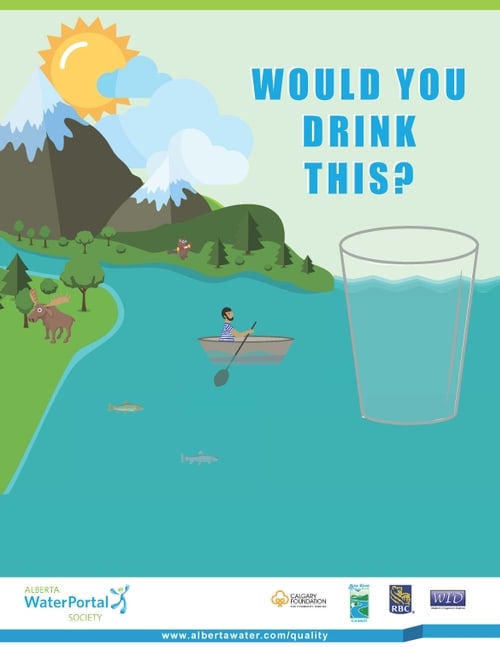Would you drink this?
Would you drink this?
Facts about the pristine-looking headwaters

Concern
How can I tell if water that looks pristine, like mountain springs or streams, is safe to consume without treatment?
Where did the concern about needing to treat water in the mountains come from?
At first glance, crystal clear water running through mountain streams looks pure and untainted by pollution. This is because the term “pollution” is often associated with industrial effluent, urban and agricultural runoff, and wastewater treatment effluent added to the river by human activities.
High in the headwaters of Alberta’s rivers, one may think the absence of human activities makes the water much safer to drink. Surface water high in the mountains may be far away from any significant form of human disturbance but it is still subject to contamination from wildlife.
What is the science behind the safety of drinking pristine-looking water?
The Government of Alberta puts it simply: assume that any untreated surface water is unsafe to drink.
Parasites, including Giardia and Cryptosporidium, which naturally occur in wildlife feces can easily end up in surface waters and be carried great distances, contaminating reaches of water well downstream of the initial contact. Giardiasis, commonly referred to as beaver fever, is the infection resulting from ingestion of Giardia cysts. Symptoms of giardiasis include diarrhoea, cramps, dehydration and fatigue for up to three weeks after consumption of the contaminated food or water.
Cryptosporidium oocysts are found in fecal matter from humans, livestock, and wildlife. The oocyst is hardy and environmentally stable, allowing it to be transmitted easily from a host organism, such as a wild animal, to humans through water. Direct contact of feces with a water source or introduction via runoff can contaminate lakes, rivers and streams no matter how far they are from human sources of pollution. Symptoms of cryptosporidiosis resemble those of giardiasis, including diarrhoea, fever, and dehydration.
Both Giardia cysts and Cryptosporidium oocysts are too small to be seen with the naked eye. This means even though the water may look crystal clear it could be contaminated with these potentially harmful organisms.
What is being done?
Creating awareness of the risks associated with drinking untreated surface water helps prevent accidental or intentional consumption of contaminated water in the wilderness.
The Canadian Drinking Water Guidelines, which Alberta has adopted, specify removal of both Giardia and Cryptosporidium from drinking water along with a host of other microbial parameters that could cause illness.
What can I do about drinking from pristine headwaters?
As the Government of Alberta states: assume that any untreated surface water is unsafe to drink.
There are methods for treating water upstream of large scale treatment plants, but the consumer is responsible for becoming familiar with which methods are effective at removing each type of potentially harmful waterborne organism.
Water can be treated to kill Giardia cysts through boiling, and certain filtration methods will remove the cysts altogether. Interestingly, standard chlorination concentrations that will kill most other harmful organisms will not kill Giardia cysts.
Filtration and disinfection with UV light are more effective at removing Cryptosporidium oocysts than chlorine treatment, and boiling for at least one minute will also kill Cryptosporidium.
Campers, hikers and other backcountry users should carefully research portable water treatment options.
Sources and additional information
Alberta Environment and Parks. (2015). Surface Water Quality Program. Retrieved May 11, 2017, from http://aep.alberta.ca/water/programs-and-services/surface-water-quality-program/
Alberta Environment and Parks. (2017). Alberta River Water Quality Index. Retrieved July 5, 2017, from http://aep.alberta.ca/water/reports-data/alberta-river-water-quality-index.aspx
Cooke, S., Mitchell, P., Roy, L., Gammie, L., Olson, M., Shepel, C., Chanasyk, D. (2002). Relationship Between Beef Production and Waterborne Parasites in the North Saskatchewan River Basin. Retrieved from http://www1.agric.gov.ab.ca/$department/deptdocs.nsf/all/wat6400
Health Canada. (2007). Water Talk: Drinking water quality in Canada. Retrieved from http://www.hc-sc.gc.ca/ewh-semt/alt_formats/hecs-sesc/pdf/pubs/water-eau/drink-potab-eng.pdf
Health Canada. (2012). Guidelines for Canadian Drinking Water Quality: Guideline Technical Document – Enteric Protozoa: Giardia and Cryptosporidium. Retrieved from http://healthycanadians.gc.ca/publications/healthy-living-vie-saine/water-enteric-virus-enterique-eau/index-eng.php
University of Alberta. (2014). Giardiasis in Alberta. What’s Bugging Wild Critters? Fact Sheet #37: Giardiasis. Retrieved from http://aep.alberta.ca/fish-wildlife/wildlife-diseases/documents/Giardiasis-Oct-2014.pdf
